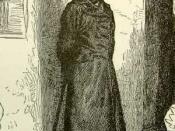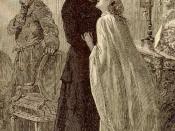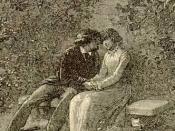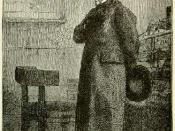Les Miserables After reading Les Miserables, it is without a doubt that there are many reoccurring themes of biographical outlines for characters. Along with that, there is the aspect of forgiveness, courage, and sacrifice. These are only a few of the main themes Hugo wanted to build up in Les Miserables. Uses theme of forgiveness"æ"æ"æ.
Victor Hugo's target was to write a historical novel. This is expressed through the way the novel is affected by the French Revolution. Forgiveness, a repetitive theme in many novels took place in the beginning of Les Miserables when the bishop M. Myriel forgave Jean Valjean for stealing his silver, so that he could have another chance at life.
Secondly, sacrifice is shown by Jean Valjean in many events through out the novel, but the most surprising is when he saves his taken-in daughter's lover's life. This is surprising because he feared of losing Cosette, his daughter to her lover.
Lastly, courage is shown by Valjean when most others wouldn't care to help or assist. For example when a man gets stuck on a rope on top of a ship, Valjean is the only one to help him and also turns out to help in his own escape.
In Les Miserables you can easily identify the author's tone. Through the characters, Jean Valjean and Fantine you can see Victor Hugo's criticism of society.
He blames society for the continuation of Fantine's dilemmas. For example, even though selling one's hair and teeth and becoming a prostitute are repulsive actions, society is a willing buyer. A main theme, the French Revolution showed Hugo's political interest and beliefs. Another point the author tried to make across was the failure of the French criminal justice system. In Jean Valjean's case there is "greater abuse in the penalty than in the crime."ÃÂ In the first section of the novel, Hugo questions reform. Valjean's nineteen years in prison only made him more dangerous than before he was put in. However, Hugo showed that there can be rehabilitation through forgiveness when Myriel gave Valjean a second chance. The author's diction is of early English from the 1800's. The syntax is also of English from the 1800's, where the sentence structure is composed.
The point of the view in Les Miserables is third person omniscient. Third person omniscient means we know the actions and emotions of every character according to the narrator. The narrators way of displaying the new, developed character of Valjean without directly telling the reader was a great way to make the reader aware of the main characters changing personality. This specifically happened when Valjean entered Montfermeil-sur-mer as Madeleine. A disappointment of the narrator was when he didn't describe certain points of the novel enough. For example, when one of Valjean's numerous escapes from prison occurred. Valjean tried to save a man and at the same time escape, the narrator quickly and briefly went through this situation.
If the point of view for the novel specifically came from Cosette, it would be more specific on her hardships and Miserables. In the novel, you would probably see Valjean as more of a father figure than and a hero to degree.
Conflict is a part of almost every character in Les Miserables. In the main character Jean Valjean, there is both an internal and external conflict and with more then 1 in some cases. In the beginning of the novel, Valjean's internal conflict is showed to himself when he takes a little boy's money. Valjean almost suddenly saw the wickedness of his actions and what nineteen years of prison had done to him. This event is the climax of his internal conflict and is quickly resolved when he reaches Montfermeil-sur-mer, where he changes his whole lifestyle by bringing prosperity and helping others. He uses his old friend, Myriel's forgiveness as a reminder to him. That whole internal conflict is what spurred Jean Valjean to change his ways and therefore changing all his actions, which affect the novel overall.
A particular external conflict, which Valjean encountered was a police officer name Javert. Javert having known Valjean since the galleys was one whole disliked him very much. Valjean had taken another identity in Montfermeil. Javert had become suspicious of this new face and this is when Valjean had acquired a closer enemy. From this point, Javert has a major affect on the novel, by causing Valjean to escape and having to stay hidden. This external conflict reaches its climax when Valjean has a legible opportunity to kill Javert, because he is accused of being a traitor. However, Valjean lets him free. Soon after, Javert has a complete opportunity to take Valjean in custody, but lets him free. This conflict is resolved when Javert drowns himself the same night.
Cosette, another major character in Les Miserables experiences an internal conflict. Near the end of the novel, she is broken in between choosing her love or her father. She must decide to leave with Valjean or stay with her lover, Marius. The climax is reached when Valjean saves Marius's life, knowing that he might lose Cosette forever.
The situation is resolved when Cosette's and Marius are married.





